Improving Hospital Ancillary Department: A Proposed Solution
VerifiedAdded on 2023/01/19
|9
|1554
|75
Report
AI Summary
This report addresses critical issues within a hospital's ancillary service department, focusing on staff turnover due to job dissatisfaction and challenges arising from mergers or consolidation of services. The introduction highlights the importance of teamwork, collaboration, and communication for effective patient-centered healthcare. The report identifies the impacts of mergers, such as lack of commitment and reluctance to share information, along with high staff turnover due to work overload and dissatisfaction. The proposed solution emphasizes improved collaboration, teamwork, and communication across departments. Recommendations include defining consensus to retain qualified staff, empowering employees to improve engagement, and increasing staff engagement through transparency. The conclusion summarizes the identified issues and proposed solutions, emphasizing the importance of team dynamics, collaborative workforce, and effective communication for enhancing patient care and organizational success. The report provides a comprehensive overview of problems and provides practical, actionable strategies to improve the performance and outcomes of the ancillary department.
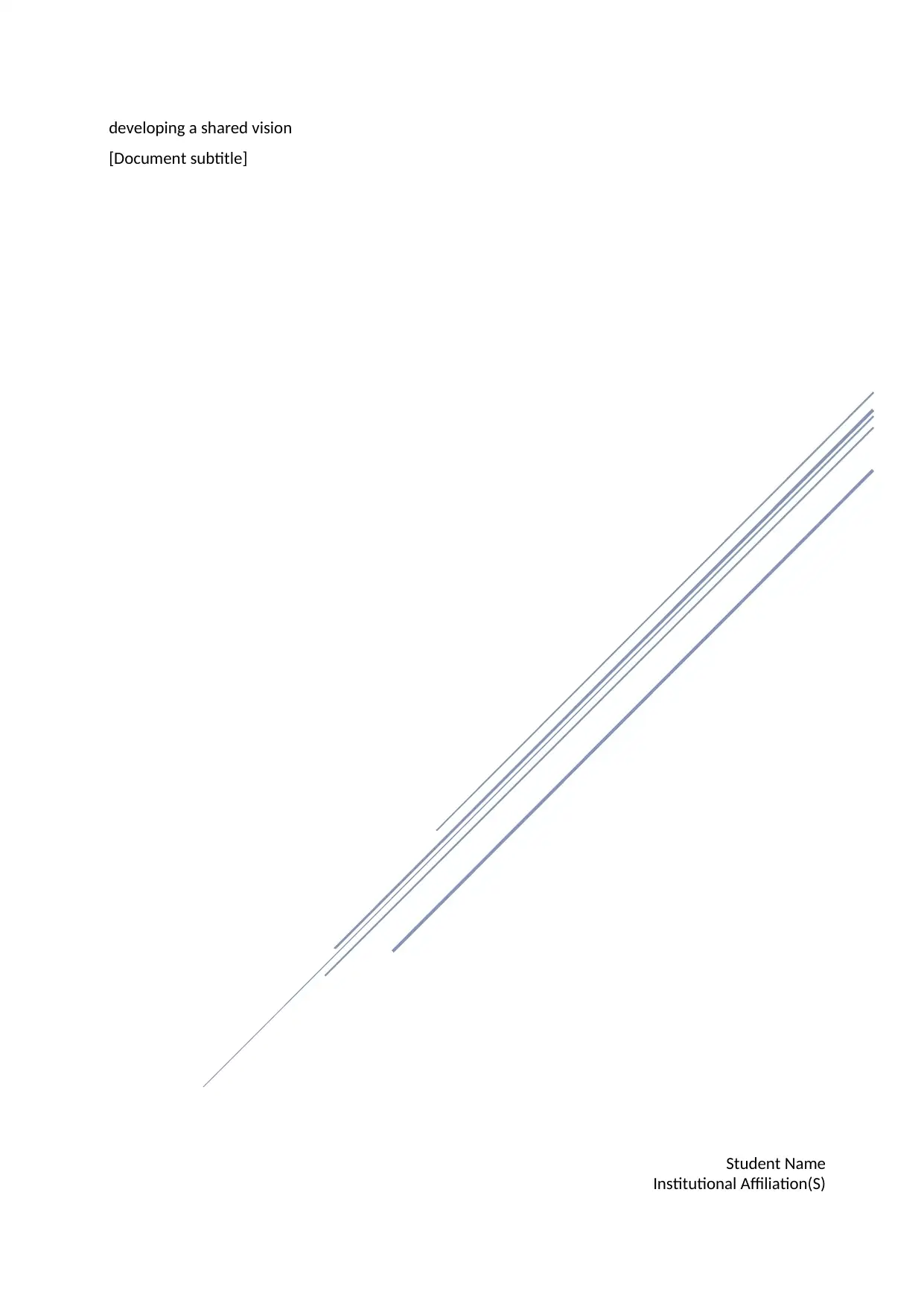
Student Name
Institutional Affiliation(S)
developing a shared vision
[Document subtitle]
Institutional Affiliation(S)
developing a shared vision
[Document subtitle]
Paraphrase This Document
Need a fresh take? Get an instant paraphrase of this document with our AI Paraphraser
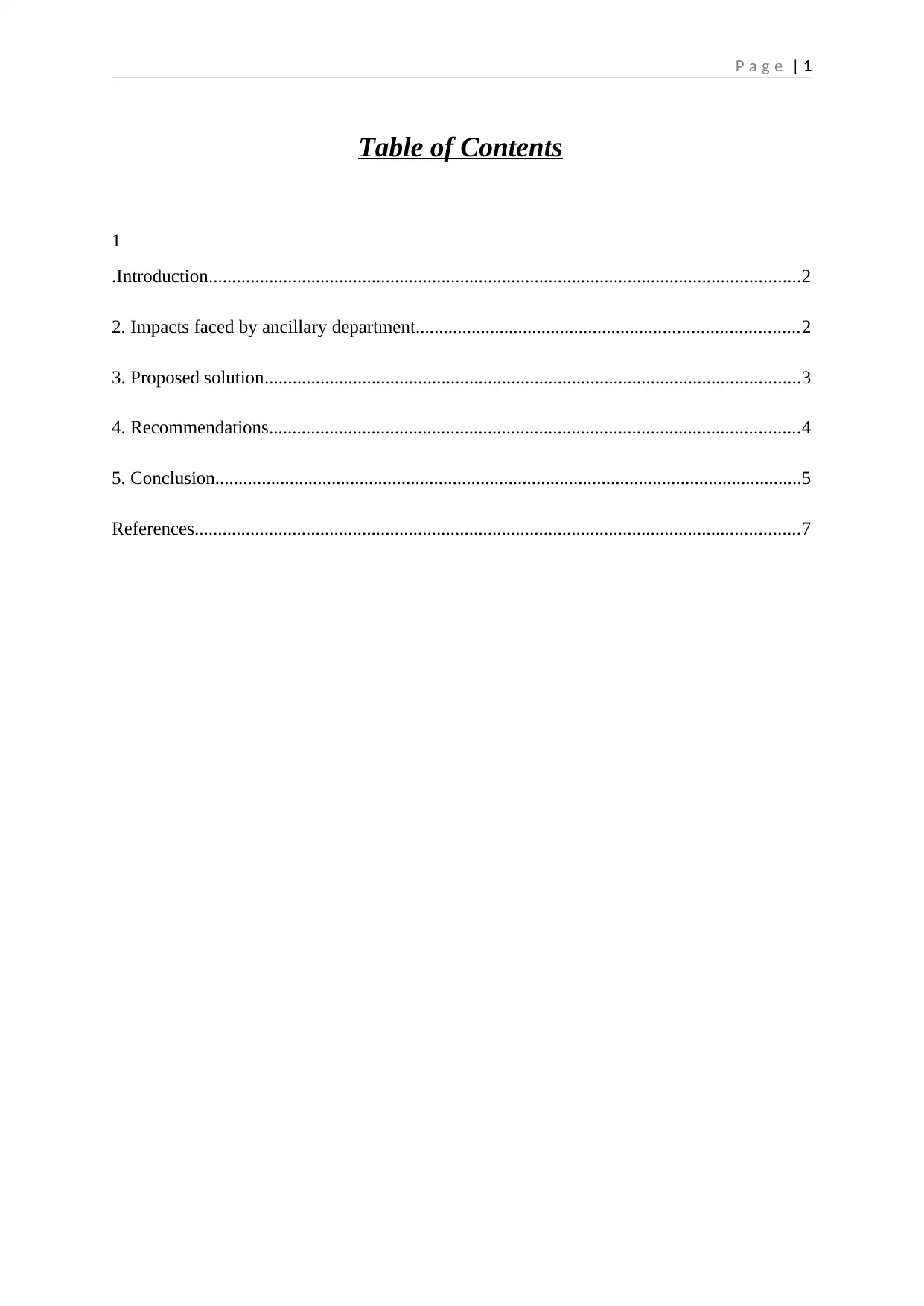
P a g e | 1
Table of Contents
1
.Introduction...............................................................................................................................2
2. Impacts faced by ancillary department..................................................................................2
3. Proposed solution...................................................................................................................3
4. Recommendations..................................................................................................................4
5. Conclusion..............................................................................................................................5
References..................................................................................................................................7
Table of Contents
1
.Introduction...............................................................................................................................2
2. Impacts faced by ancillary department..................................................................................2
3. Proposed solution...................................................................................................................3
4. Recommendations..................................................................................................................4
5. Conclusion..............................................................................................................................5
References..................................................................................................................................7
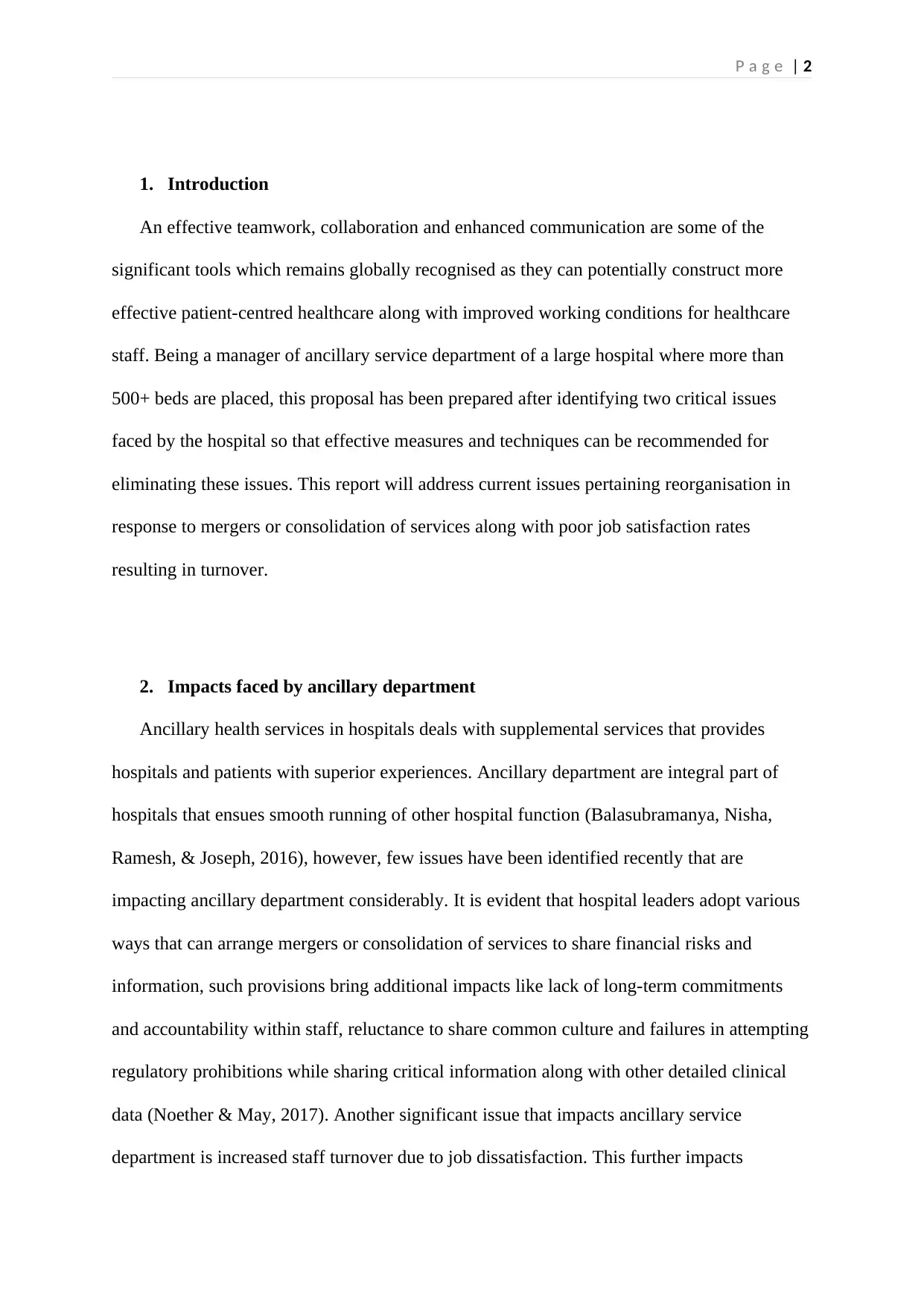
P a g e | 2
1. Introduction
An effective teamwork, collaboration and enhanced communication are some of the
significant tools which remains globally recognised as they can potentially construct more
effective patient-centred healthcare along with improved working conditions for healthcare
staff. Being a manager of ancillary service department of a large hospital where more than
500+ beds are placed, this proposal has been prepared after identifying two critical issues
faced by the hospital so that effective measures and techniques can be recommended for
eliminating these issues. This report will address current issues pertaining reorganisation in
response to mergers or consolidation of services along with poor job satisfaction rates
resulting in turnover.
2. Impacts faced by ancillary department
Ancillary health services in hospitals deals with supplemental services that provides
hospitals and patients with superior experiences. Ancillary department are integral part of
hospitals that ensues smooth running of other hospital function (Balasubramanya, Nisha,
Ramesh, & Joseph, 2016), however, few issues have been identified recently that are
impacting ancillary department considerably. It is evident that hospital leaders adopt various
ways that can arrange mergers or consolidation of services to share financial risks and
information, such provisions bring additional impacts like lack of long-term commitments
and accountability within staff, reluctance to share common culture and failures in attempting
regulatory prohibitions while sharing critical information along with other detailed clinical
data (Noether & May, 2017). Another significant issue that impacts ancillary service
department is increased staff turnover due to job dissatisfaction. This further impacts
1. Introduction
An effective teamwork, collaboration and enhanced communication are some of the
significant tools which remains globally recognised as they can potentially construct more
effective patient-centred healthcare along with improved working conditions for healthcare
staff. Being a manager of ancillary service department of a large hospital where more than
500+ beds are placed, this proposal has been prepared after identifying two critical issues
faced by the hospital so that effective measures and techniques can be recommended for
eliminating these issues. This report will address current issues pertaining reorganisation in
response to mergers or consolidation of services along with poor job satisfaction rates
resulting in turnover.
2. Impacts faced by ancillary department
Ancillary health services in hospitals deals with supplemental services that provides
hospitals and patients with superior experiences. Ancillary department are integral part of
hospitals that ensues smooth running of other hospital function (Balasubramanya, Nisha,
Ramesh, & Joseph, 2016), however, few issues have been identified recently that are
impacting ancillary department considerably. It is evident that hospital leaders adopt various
ways that can arrange mergers or consolidation of services to share financial risks and
information, such provisions bring additional impacts like lack of long-term commitments
and accountability within staff, reluctance to share common culture and failures in attempting
regulatory prohibitions while sharing critical information along with other detailed clinical
data (Noether & May, 2017). Another significant issue that impacts ancillary service
department is increased staff turnover due to job dissatisfaction. This further impacts
⊘ This is a preview!⊘
Do you want full access?
Subscribe today to unlock all pages.

Trusted by 1+ million students worldwide
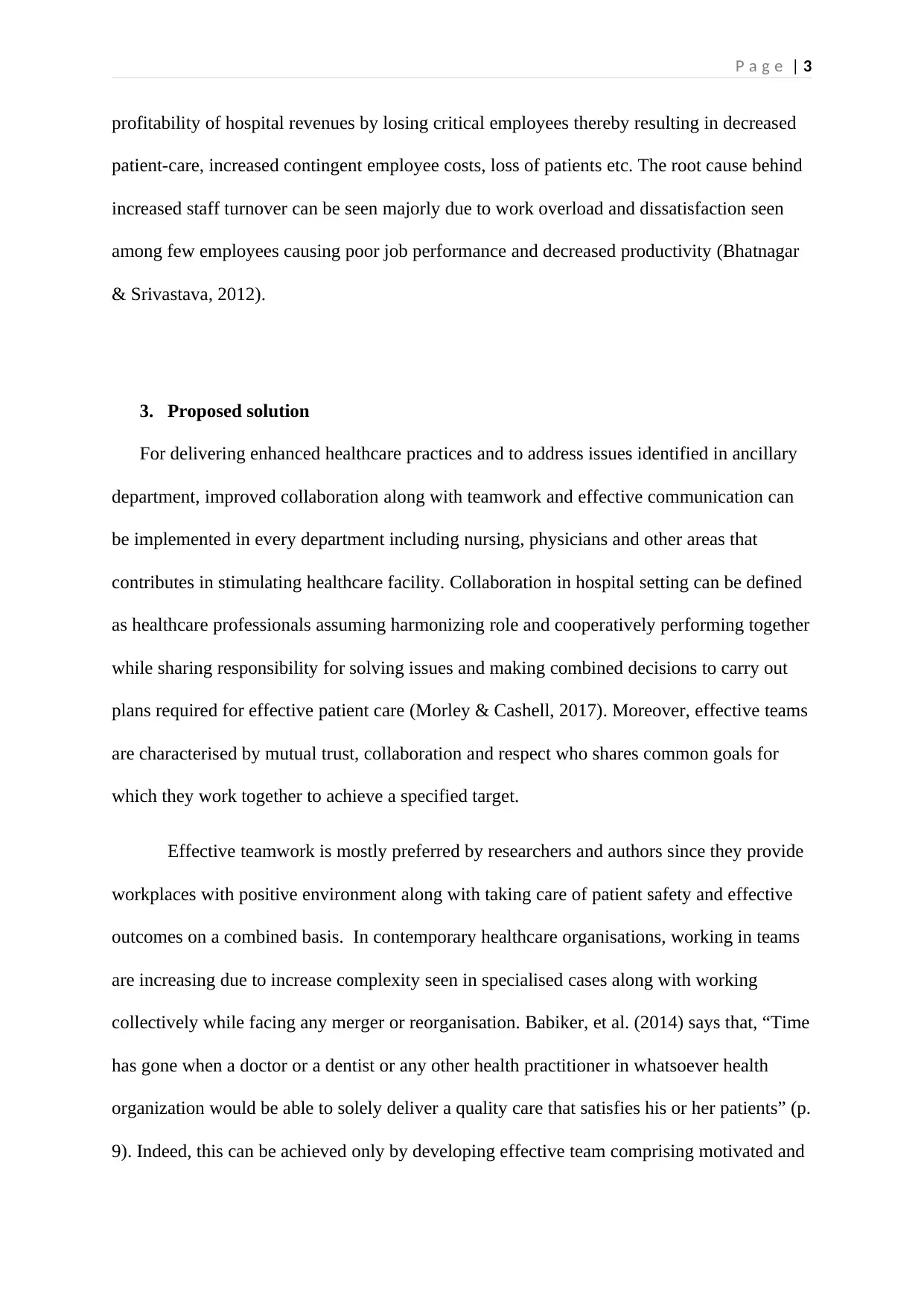
P a g e | 3
profitability of hospital revenues by losing critical employees thereby resulting in decreased
patient-care, increased contingent employee costs, loss of patients etc. The root cause behind
increased staff turnover can be seen majorly due to work overload and dissatisfaction seen
among few employees causing poor job performance and decreased productivity (Bhatnagar
& Srivastava, 2012).
3. Proposed solution
For delivering enhanced healthcare practices and to address issues identified in ancillary
department, improved collaboration along with teamwork and effective communication can
be implemented in every department including nursing, physicians and other areas that
contributes in stimulating healthcare facility. Collaboration in hospital setting can be defined
as healthcare professionals assuming harmonizing role and cooperatively performing together
while sharing responsibility for solving issues and making combined decisions to carry out
plans required for effective patient care (Morley & Cashell, 2017). Moreover, effective teams
are characterised by mutual trust, collaboration and respect who shares common goals for
which they work together to achieve a specified target.
Effective teamwork is mostly preferred by researchers and authors since they provide
workplaces with positive environment along with taking care of patient safety and effective
outcomes on a combined basis. In contemporary healthcare organisations, working in teams
are increasing due to increase complexity seen in specialised cases along with working
collectively while facing any merger or reorganisation. Babiker, et al. (2014) says that, “Time
has gone when a doctor or a dentist or any other health practitioner in whatsoever health
organization would be able to solely deliver a quality care that satisfies his or her patients” (p.
9). Indeed, this can be achieved only by developing effective team comprising motivated and
profitability of hospital revenues by losing critical employees thereby resulting in decreased
patient-care, increased contingent employee costs, loss of patients etc. The root cause behind
increased staff turnover can be seen majorly due to work overload and dissatisfaction seen
among few employees causing poor job performance and decreased productivity (Bhatnagar
& Srivastava, 2012).
3. Proposed solution
For delivering enhanced healthcare practices and to address issues identified in ancillary
department, improved collaboration along with teamwork and effective communication can
be implemented in every department including nursing, physicians and other areas that
contributes in stimulating healthcare facility. Collaboration in hospital setting can be defined
as healthcare professionals assuming harmonizing role and cooperatively performing together
while sharing responsibility for solving issues and making combined decisions to carry out
plans required for effective patient care (Morley & Cashell, 2017). Moreover, effective teams
are characterised by mutual trust, collaboration and respect who shares common goals for
which they work together to achieve a specified target.
Effective teamwork is mostly preferred by researchers and authors since they provide
workplaces with positive environment along with taking care of patient safety and effective
outcomes on a combined basis. In contemporary healthcare organisations, working in teams
are increasing due to increase complexity seen in specialised cases along with working
collectively while facing any merger or reorganisation. Babiker, et al. (2014) says that, “Time
has gone when a doctor or a dentist or any other health practitioner in whatsoever health
organization would be able to solely deliver a quality care that satisfies his or her patients” (p.
9). Indeed, this can be achieved only by developing effective team comprising motivated and
Paraphrase This Document
Need a fresh take? Get an instant paraphrase of this document with our AI Paraphraser
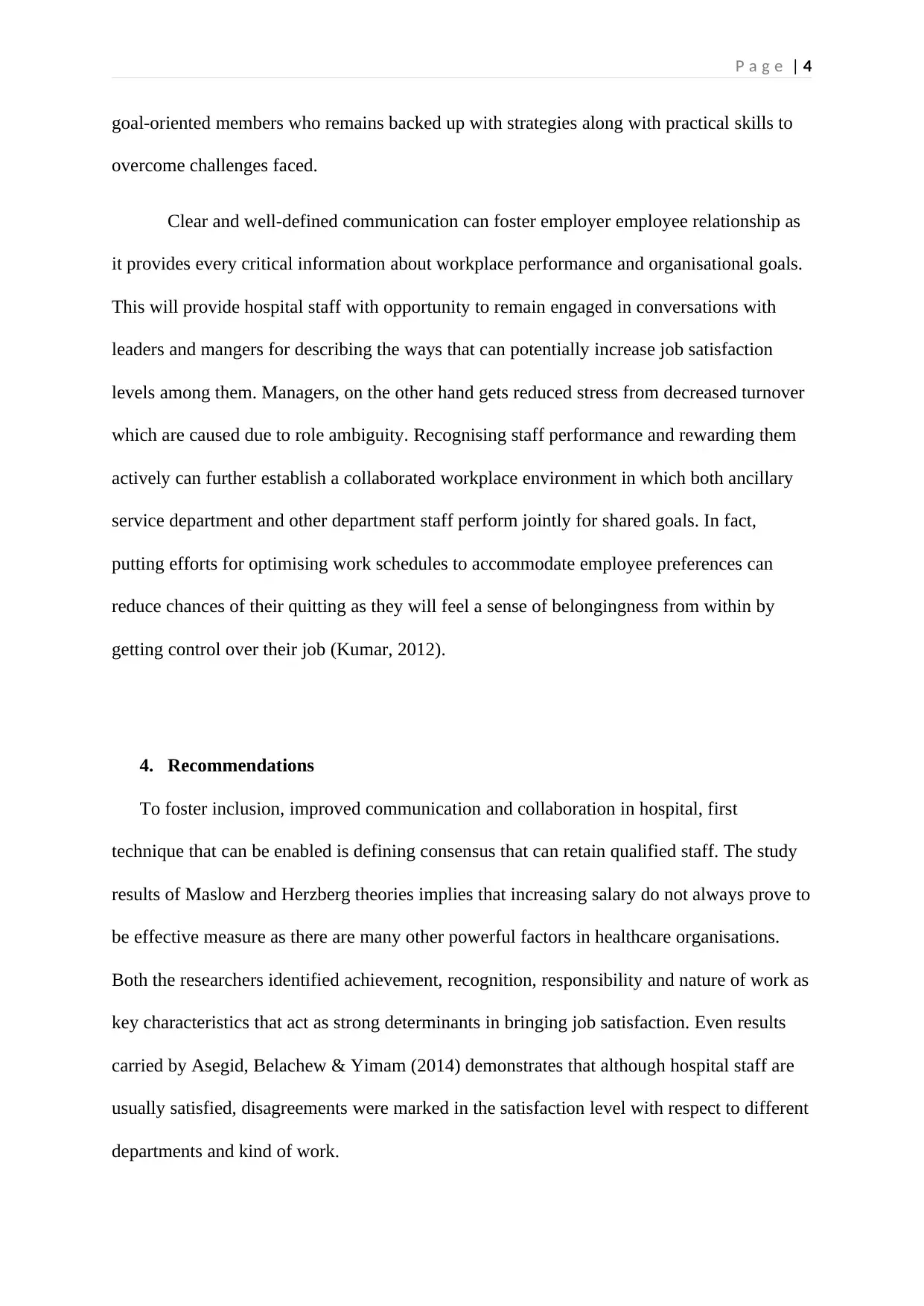
P a g e | 4
goal-oriented members who remains backed up with strategies along with practical skills to
overcome challenges faced.
Clear and well-defined communication can foster employer employee relationship as
it provides every critical information about workplace performance and organisational goals.
This will provide hospital staff with opportunity to remain engaged in conversations with
leaders and mangers for describing the ways that can potentially increase job satisfaction
levels among them. Managers, on the other hand gets reduced stress from decreased turnover
which are caused due to role ambiguity. Recognising staff performance and rewarding them
actively can further establish a collaborated workplace environment in which both ancillary
service department and other department staff perform jointly for shared goals. In fact,
putting efforts for optimising work schedules to accommodate employee preferences can
reduce chances of their quitting as they will feel a sense of belongingness from within by
getting control over their job (Kumar, 2012).
4. Recommendations
To foster inclusion, improved communication and collaboration in hospital, first
technique that can be enabled is defining consensus that can retain qualified staff. The study
results of Maslow and Herzberg theories implies that increasing salary do not always prove to
be effective measure as there are many other powerful factors in healthcare organisations.
Both the researchers identified achievement, recognition, responsibility and nature of work as
key characteristics that act as strong determinants in bringing job satisfaction. Even results
carried by Asegid, Belachew & Yimam (2014) demonstrates that although hospital staff are
usually satisfied, disagreements were marked in the satisfaction level with respect to different
departments and kind of work.
goal-oriented members who remains backed up with strategies along with practical skills to
overcome challenges faced.
Clear and well-defined communication can foster employer employee relationship as
it provides every critical information about workplace performance and organisational goals.
This will provide hospital staff with opportunity to remain engaged in conversations with
leaders and mangers for describing the ways that can potentially increase job satisfaction
levels among them. Managers, on the other hand gets reduced stress from decreased turnover
which are caused due to role ambiguity. Recognising staff performance and rewarding them
actively can further establish a collaborated workplace environment in which both ancillary
service department and other department staff perform jointly for shared goals. In fact,
putting efforts for optimising work schedules to accommodate employee preferences can
reduce chances of their quitting as they will feel a sense of belongingness from within by
getting control over their job (Kumar, 2012).
4. Recommendations
To foster inclusion, improved communication and collaboration in hospital, first
technique that can be enabled is defining consensus that can retain qualified staff. The study
results of Maslow and Herzberg theories implies that increasing salary do not always prove to
be effective measure as there are many other powerful factors in healthcare organisations.
Both the researchers identified achievement, recognition, responsibility and nature of work as
key characteristics that act as strong determinants in bringing job satisfaction. Even results
carried by Asegid, Belachew & Yimam (2014) demonstrates that although hospital staff are
usually satisfied, disagreements were marked in the satisfaction level with respect to different
departments and kind of work.
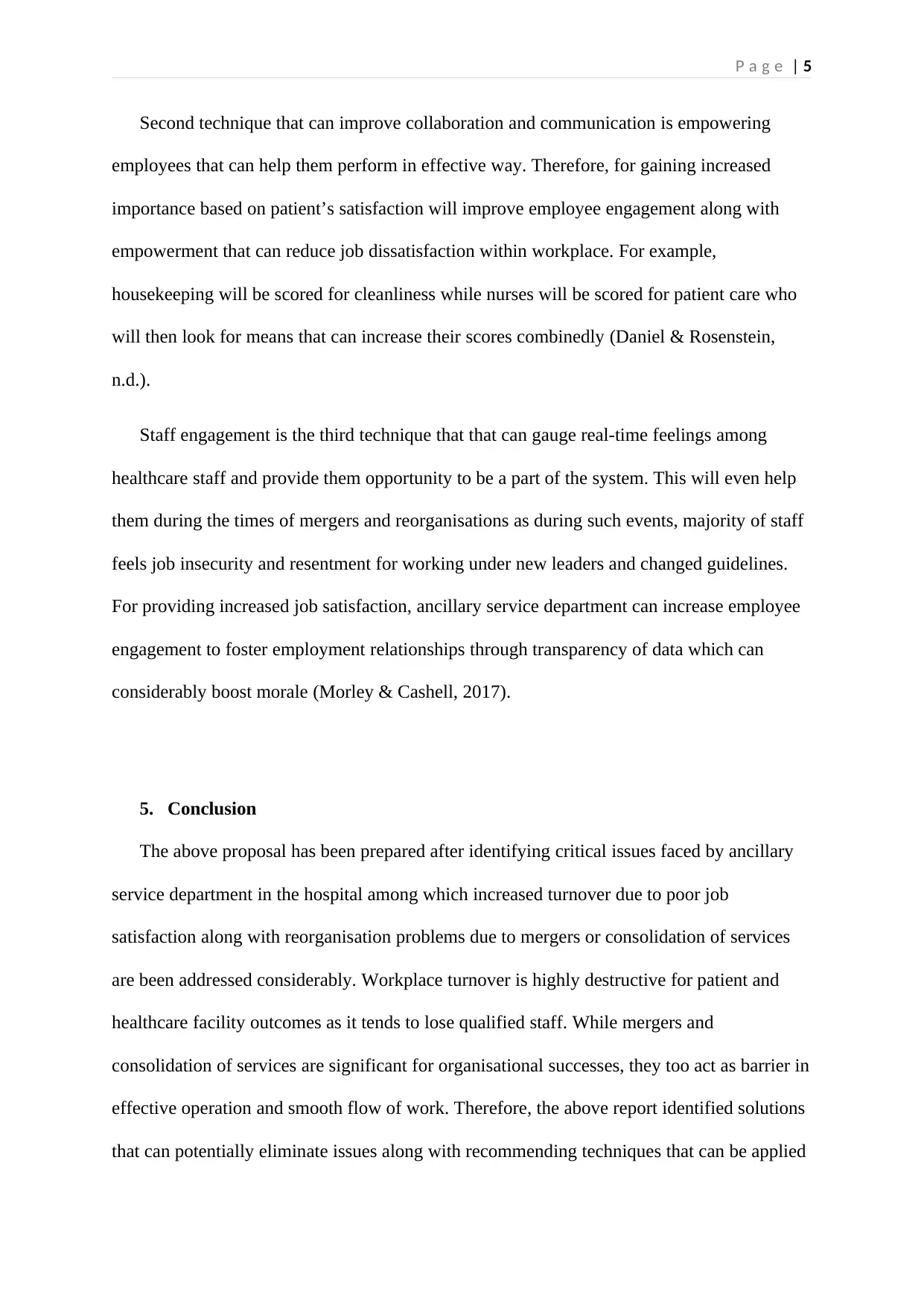
P a g e | 5
Second technique that can improve collaboration and communication is empowering
employees that can help them perform in effective way. Therefore, for gaining increased
importance based on patient’s satisfaction will improve employee engagement along with
empowerment that can reduce job dissatisfaction within workplace. For example,
housekeeping will be scored for cleanliness while nurses will be scored for patient care who
will then look for means that can increase their scores combinedly (Daniel & Rosenstein,
n.d.).
Staff engagement is the third technique that that can gauge real-time feelings among
healthcare staff and provide them opportunity to be a part of the system. This will even help
them during the times of mergers and reorganisations as during such events, majority of staff
feels job insecurity and resentment for working under new leaders and changed guidelines.
For providing increased job satisfaction, ancillary service department can increase employee
engagement to foster employment relationships through transparency of data which can
considerably boost morale (Morley & Cashell, 2017).
5. Conclusion
The above proposal has been prepared after identifying critical issues faced by ancillary
service department in the hospital among which increased turnover due to poor job
satisfaction along with reorganisation problems due to mergers or consolidation of services
are been addressed considerably. Workplace turnover is highly destructive for patient and
healthcare facility outcomes as it tends to lose qualified staff. While mergers and
consolidation of services are significant for organisational successes, they too act as barrier in
effective operation and smooth flow of work. Therefore, the above report identified solutions
that can potentially eliminate issues along with recommending techniques that can be applied
Second technique that can improve collaboration and communication is empowering
employees that can help them perform in effective way. Therefore, for gaining increased
importance based on patient’s satisfaction will improve employee engagement along with
empowerment that can reduce job dissatisfaction within workplace. For example,
housekeeping will be scored for cleanliness while nurses will be scored for patient care who
will then look for means that can increase their scores combinedly (Daniel & Rosenstein,
n.d.).
Staff engagement is the third technique that that can gauge real-time feelings among
healthcare staff and provide them opportunity to be a part of the system. This will even help
them during the times of mergers and reorganisations as during such events, majority of staff
feels job insecurity and resentment for working under new leaders and changed guidelines.
For providing increased job satisfaction, ancillary service department can increase employee
engagement to foster employment relationships through transparency of data which can
considerably boost morale (Morley & Cashell, 2017).
5. Conclusion
The above proposal has been prepared after identifying critical issues faced by ancillary
service department in the hospital among which increased turnover due to poor job
satisfaction along with reorganisation problems due to mergers or consolidation of services
are been addressed considerably. Workplace turnover is highly destructive for patient and
healthcare facility outcomes as it tends to lose qualified staff. While mergers and
consolidation of services are significant for organisational successes, they too act as barrier in
effective operation and smooth flow of work. Therefore, the above report identified solutions
that can potentially eliminate issues along with recommending techniques that can be applied
⊘ This is a preview!⊘
Do you want full access?
Subscribe today to unlock all pages.

Trusted by 1+ million students worldwide
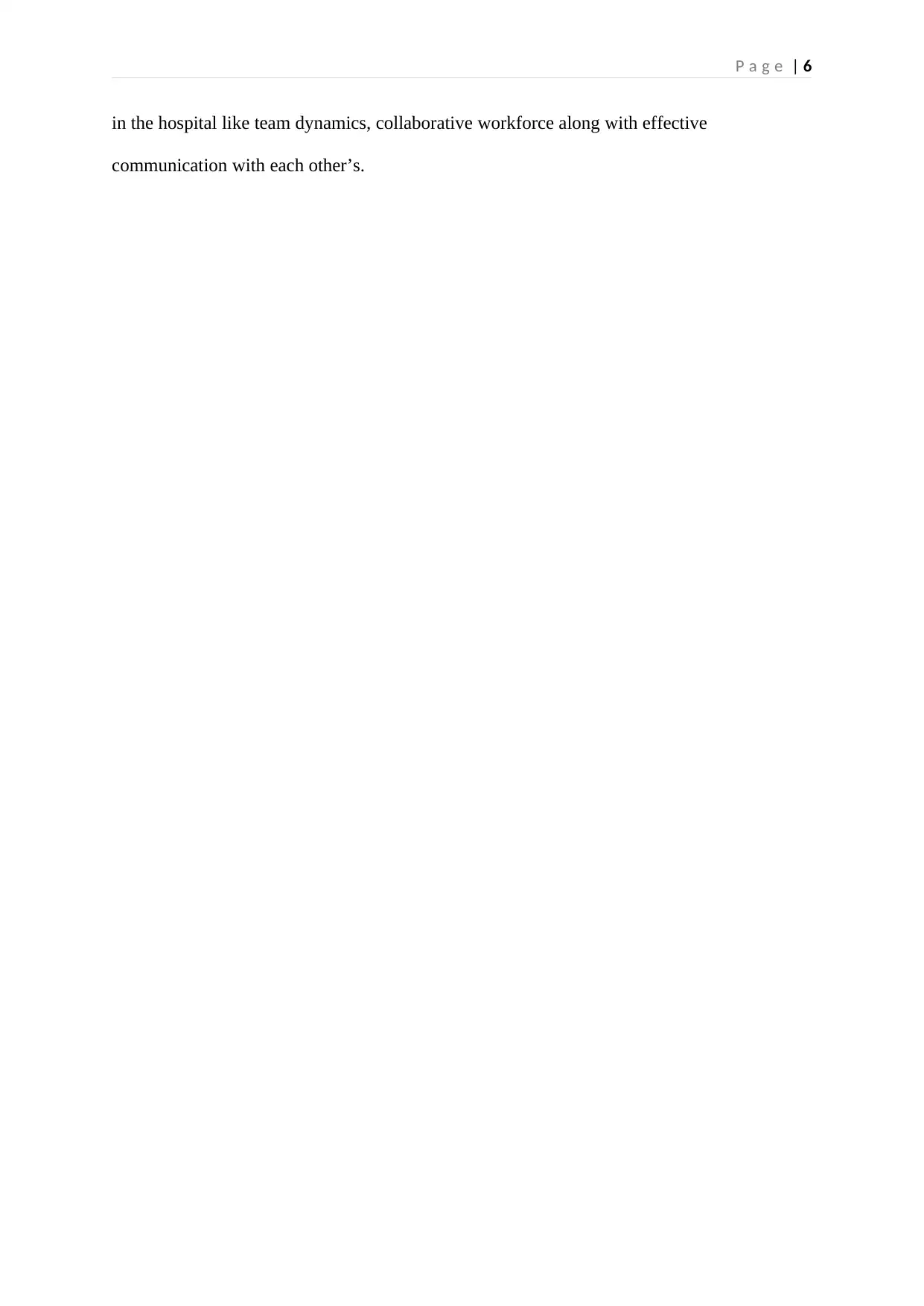
P a g e | 6
in the hospital like team dynamics, collaborative workforce along with effective
communication with each other’s.
in the hospital like team dynamics, collaborative workforce along with effective
communication with each other’s.
Paraphrase This Document
Need a fresh take? Get an instant paraphrase of this document with our AI Paraphraser
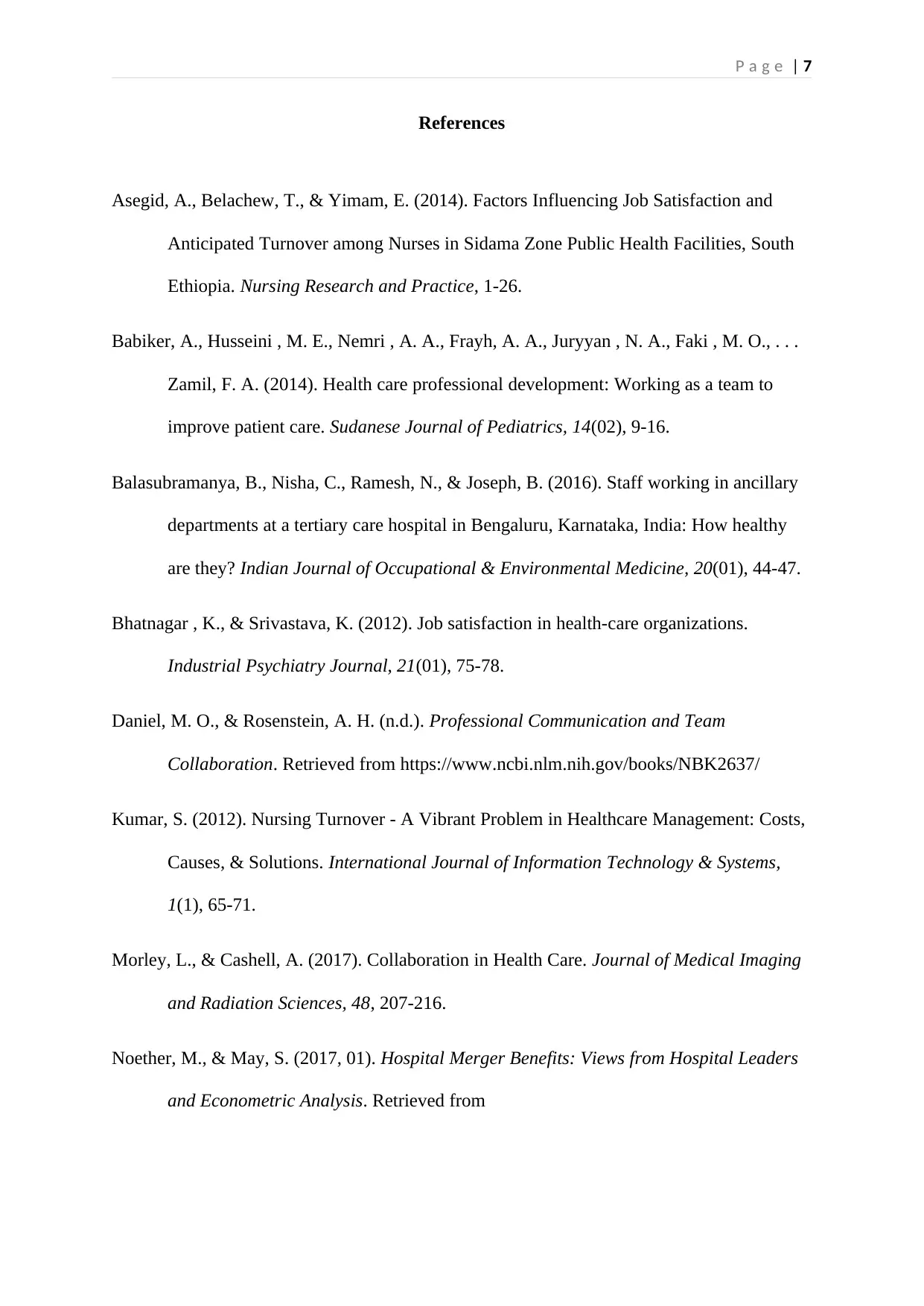
P a g e | 7
References
Asegid, A., Belachew, T., & Yimam, E. (2014). Factors Influencing Job Satisfaction and
Anticipated Turnover among Nurses in Sidama Zone Public Health Facilities, South
Ethiopia. Nursing Research and Practice, 1-26.
Babiker, A., Husseini , M. E., Nemri , A. A., Frayh, A. A., Juryyan , N. A., Faki , M. O., . . .
Zamil, F. A. (2014). Health care professional development: Working as a team to
improve patient care. Sudanese Journal of Pediatrics, 14(02), 9-16.
Balasubramanya, B., Nisha, C., Ramesh, N., & Joseph, B. (2016). Staff working in ancillary
departments at a tertiary care hospital in Bengaluru, Karnataka, India: How healthy
are they? Indian Journal of Occupational & Environmental Medicine, 20(01), 44-47.
Bhatnagar , K., & Srivastava, K. (2012). Job satisfaction in health-care organizations.
Industrial Psychiatry Journal, 21(01), 75-78.
Daniel, M. O., & Rosenstein, A. H. (n.d.). Professional Communication and Team
Collaboration. Retrieved from https://www.ncbi.nlm.nih.gov/books/NBK2637/
Kumar, S. (2012). Nursing Turnover - A Vibrant Problem in Healthcare Management: Costs,
Causes, & Solutions. International Journal of Information Technology & Systems,
1(1), 65-71.
Morley, L., & Cashell, A. (2017). Collaboration in Health Care. Journal of Medical Imaging
and Radiation Sciences, 48, 207-216.
Noether, M., & May, S. (2017, 01). Hospital Merger Benefits: Views from Hospital Leaders
and Econometric Analysis. Retrieved from
References
Asegid, A., Belachew, T., & Yimam, E. (2014). Factors Influencing Job Satisfaction and
Anticipated Turnover among Nurses in Sidama Zone Public Health Facilities, South
Ethiopia. Nursing Research and Practice, 1-26.
Babiker, A., Husseini , M. E., Nemri , A. A., Frayh, A. A., Juryyan , N. A., Faki , M. O., . . .
Zamil, F. A. (2014). Health care professional development: Working as a team to
improve patient care. Sudanese Journal of Pediatrics, 14(02), 9-16.
Balasubramanya, B., Nisha, C., Ramesh, N., & Joseph, B. (2016). Staff working in ancillary
departments at a tertiary care hospital in Bengaluru, Karnataka, India: How healthy
are they? Indian Journal of Occupational & Environmental Medicine, 20(01), 44-47.
Bhatnagar , K., & Srivastava, K. (2012). Job satisfaction in health-care organizations.
Industrial Psychiatry Journal, 21(01), 75-78.
Daniel, M. O., & Rosenstein, A. H. (n.d.). Professional Communication and Team
Collaboration. Retrieved from https://www.ncbi.nlm.nih.gov/books/NBK2637/
Kumar, S. (2012). Nursing Turnover - A Vibrant Problem in Healthcare Management: Costs,
Causes, & Solutions. International Journal of Information Technology & Systems,
1(1), 65-71.
Morley, L., & Cashell, A. (2017). Collaboration in Health Care. Journal of Medical Imaging
and Radiation Sciences, 48, 207-216.
Noether, M., & May, S. (2017, 01). Hospital Merger Benefits: Views from Hospital Leaders
and Econometric Analysis. Retrieved from
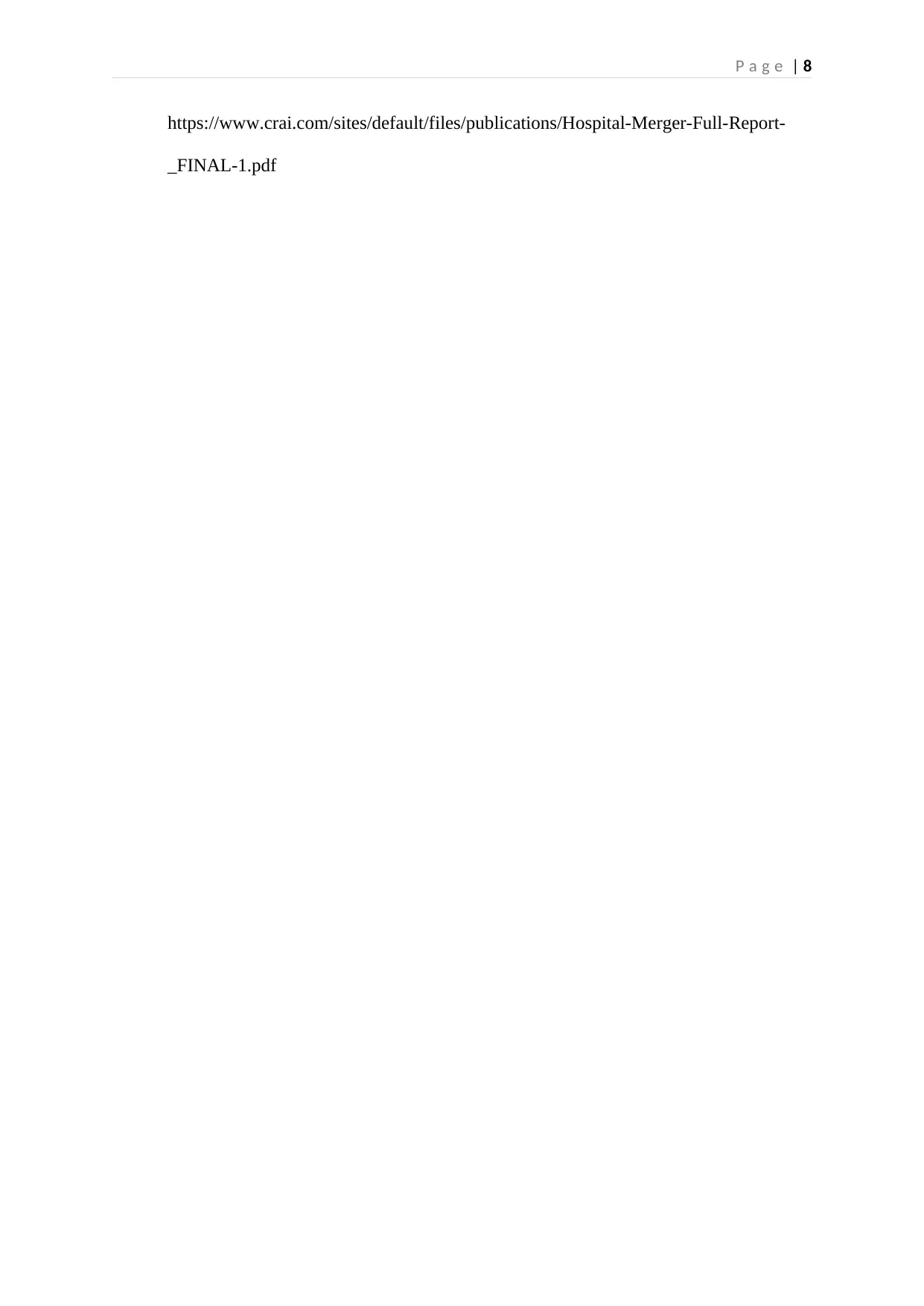
P a g e | 8
https://www.crai.com/sites/default/files/publications/Hospital-Merger-Full-Report-
_FINAL-1.pdf
https://www.crai.com/sites/default/files/publications/Hospital-Merger-Full-Report-
_FINAL-1.pdf
⊘ This is a preview!⊘
Do you want full access?
Subscribe today to unlock all pages.

Trusted by 1+ million students worldwide
1 out of 9
Related Documents
Your All-in-One AI-Powered Toolkit for Academic Success.
+13062052269
info@desklib.com
Available 24*7 on WhatsApp / Email
![[object Object]](/_next/static/media/star-bottom.7253800d.svg)
Unlock your academic potential
Copyright © 2020–2025 A2Z Services. All Rights Reserved. Developed and managed by ZUCOL.





